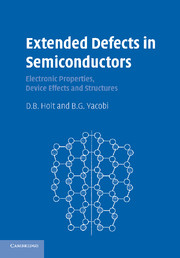Book contents
- Frontmatter
- Contents
- Preface
- 1 Semiconducting materials
- 2 An introduction to extended defects
- 3 Characterization of extended defects in semiconductors
- 4 Core structures and mechanical effects of extended defects specific to semiconductors
- 5 The electrical, optical and device effects of dislocations and grain boundaries
- 6 Point defect materials problems
- Index
- References
1 - Semiconducting materials
Published online by Cambridge University Press: 10 September 2009
- Frontmatter
- Contents
- Preface
- 1 Semiconducting materials
- 2 An introduction to extended defects
- 3 Characterization of extended defects in semiconductors
- 4 Core structures and mechanical effects of extended defects specific to semiconductors
- 5 The electrical, optical and device effects of dislocations and grain boundaries
- 6 Point defect materials problems
- Index
- References
Summary
Materials development and crystal growth techniques
This chapter outlines the nature and importance of semiconductors. The industrially important semiconductors are tetrahedrally coordinated, diamond and related structure IVB, III-V and related materials. The sp3 tetrahedral covalent bonding is stiff and brittle, unlike the metallic bond, which merely requires closest packing to minimize the energy. The atomic core structures of extended defects in semiconductors depend on this stiff, brittle bonding and in turn give rise to the electrical and optical properties of defects.
The semiconductors' closely related adamantine (diamond-like) crystal structures and energy band diagrams are outlined. There are a large number of families of such semiconducting compounds and alloys, some of which are non-crystalline. However, only a few have been developed to the highest levels of purity and perfection so that single crystal wafers are available. Instead, with modern epitaxial growth techniques, thin films, quantum wells, wires and dots and artificial superlattices can be produced. This can be done with many semiconductor materials, including alloys of continuously variable composition, with the necessary quality on one of the few available types of wafer. These epitaxial materials have ‘engineered’ energy band structures and hence electronic and optoelectronic properties and can be designed for incorporation into devices to meet new needs. It is largely to this field that materials development has moved, except for the occasional development of an additional material like GaN.
The chapter closes with a brief account of the way that competitive materials development, responding to economic demand, determines which materials enter production.
- Type
- Chapter
- Information
- Extended Defects in SemiconductorsElectronic Properties, Device Effects and Structures, pp. 1 - 72Publisher: Cambridge University PressPrint publication year: 2007

